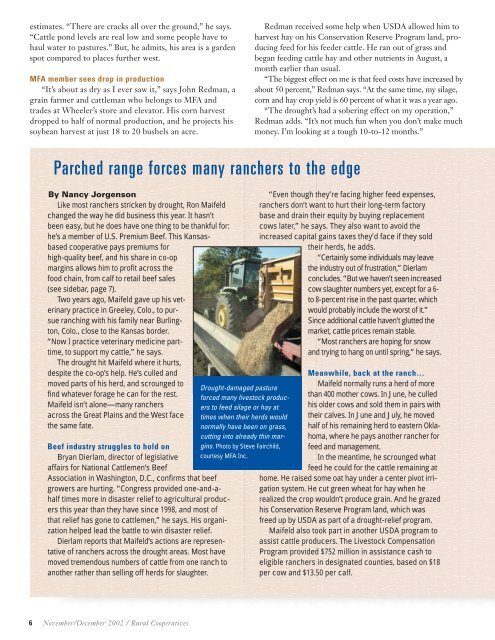1031924 Rur Coop-Nov/Dec 02 - USDA Rural Development - US ...
1031924 Rur Coop-Nov/Dec 02 - USDA Rural Development - US ...
1031924 Rur Coop-Nov/Dec 02 - USDA Rural Development - US ...
You also want an ePaper? Increase the reach of your titles
YUMPU automatically turns print PDFs into web optimized ePapers that Google loves.
estimates. “There are cracks all over the ground,” he says.<br />
“Cattle pond levels are real low and some people have to<br />
haul water to pastures.” But, he admits, his area is a garden<br />
spot compared to places further west.<br />
MFA member sees drop in production<br />
“It’s about as dry as I ever saw it,” says John Redman, a<br />
grain farmer and cattleman who belongs to MFA and<br />
trades at Wheeler’s store and elevator. His corn harvest<br />
dropped to half of normal production, and he projects his<br />
soybean harvest at just 18 to 20 bushels an acre.<br />
By Nancy Jorgenson<br />
Like most ranchers stricken by drought, Ron Maifeld<br />
changed the way he did business this year. It hasn’t<br />
been easy, but he does have one thing to be thankful for:<br />
he’s a member of U.S. Premium Beef. This Kansasbased<br />
cooperative pays premiums for<br />
high-quality beef, and his share in co-op<br />
margins allows him to profit across the<br />
food chain, from calf to retail beef sales<br />
(see sidebar, page 7).<br />
Two years ago, Maifeld gave up his veterinary<br />
practice in Greeley, Colo., to pursue<br />
ranching with his family near Burlington,<br />
Colo., close to the Kansas border.<br />
“Now I practice veterinary medicine parttime,<br />
to support my cattle,” he says.<br />
The drought hit Maifeld where it hurts,<br />
despite the co-op’s help. He’s culled and<br />
moved parts of his herd, and scrounged to<br />
find whatever forage he can for the rest.<br />
Maifeld isn’t alone—many ranchers<br />
across the Great Plains and the West face<br />
the same fate.<br />
Beef industry struggles to hold on<br />
Bryan Dierlam, director of legislative<br />
affairs for National Cattlemen’s Beef<br />
Association in Washington, D.C., confirms that beef<br />
growers are hurting. “Congress provided one-and-ahalf<br />
times more in disaster relief to agricultural producers<br />
this year than they have since 1998, and most of<br />
that relief has gone to cattlemen,” he says. His organization<br />
helped lead the battle to win disaster relief.<br />
Dierlam reports that Maifeld’s actions are representative<br />
of ranchers across the drought areas. Most have<br />
moved tremendous numbers of cattle from one ranch to<br />
another rather than selling off herds for slaughter.<br />
Redman received some help when <strong><strong>US</strong>DA</strong> allowed him to<br />
harvest hay on his Conservation Reserve Program land, producing<br />
feed for his feeder cattle. He ran out of grass and<br />
began feeding cattle hay and other nutrients in August, a<br />
month earlier than usual.<br />
“The biggest effect on me is that feed costs have increased by<br />
about 50 percent,” Redman says. “At the same time, my silage,<br />
corn and hay crop yield is 60 percent of what it was a year ago.<br />
“The drought’s had a sobering effect on my operation,”<br />
Redman adds. “It’s not much fun when you don’t make much<br />
money. I’m looking at a tough 10-to-12 months.”<br />
Parched range forces many ranchers to the edge<br />
6 <strong>Nov</strong>ember/<strong>Dec</strong>ember 20<strong>02</strong> / <strong>Rur</strong>al <strong>Coop</strong>eratives<br />
Drought-damaged pasture<br />
forced many livestock producers<br />
to feed silage or hay at<br />
times when their herds would<br />
normally have been on grass,<br />
cutting into already thin margins.<br />
Photo by Steve Fairchild,<br />
courtesy MFA Inc.<br />
“Even though they’re facing higher feed expenses,<br />
ranchers don’t want to hurt their long-term factory<br />
base and drain their equity by buying replacement<br />
cows later,” he says. They also want to avoid the<br />
increased capital gains taxes they’d face if they sold<br />
their herds, he adds.<br />
“Certainly some individuals may leave<br />
the industry out of frustration,” Dierlam<br />
concludes. “But we haven’t seen increased<br />
cow slaughter numbers yet, except for a 6to<br />
8-percent rise in the past quarter, which<br />
would probably include the worst of it.”<br />
Since additional cattle haven’t glutted the<br />
market, cattle prices remain stable.<br />
“Most ranchers are hoping for snow<br />
and trying to hang on until spring,” he says.<br />
Meanwhile, back at the ranch…<br />
Maifeld normally runs a herd of more<br />
than 400 mother cows. In June, he culled<br />
his older cows and sold them in pairs with<br />
their calves. In June and July, he moved<br />
half of his remaining herd to eastern Oklahoma,<br />
where he pays another rancher for<br />
feed and management.<br />
In the meantime, he scrounged what<br />
feed he could for the cattle remaining at<br />
home. He raised some oat hay under a center pivot irrigation<br />
system. He cut green wheat for hay when he<br />
realized the crop wouldn’t produce grain. And he grazed<br />
his Conservation Reserve Program land, which was<br />
freed up by <strong><strong>US</strong>DA</strong> as part of a drought-relief program.<br />
Maifeld also took part in another <strong><strong>US</strong>DA</strong> program to<br />
assist cattle producers. The Livestock Compensation<br />
Program provided $752 million in assistance cash to<br />
eligible ranchers in designated counties, based on $18<br />
per cow and $13.50 per calf.
















